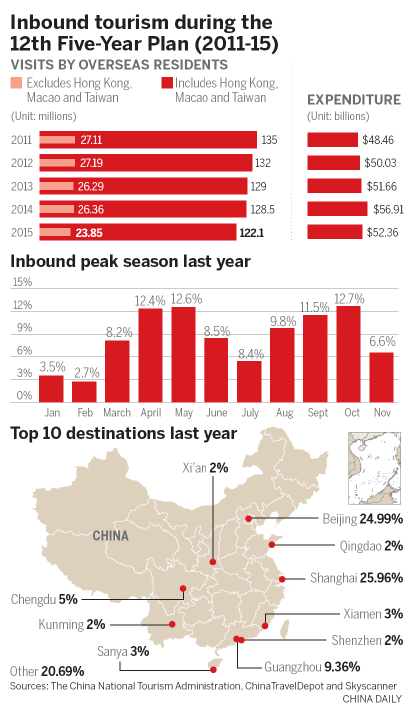One-way traffic prompts tourism revamp
Updated: 2016-01-12 09:30
By Su Zhou(China Daily)
|
||||||||
China is trying to build itself into an international destination for foreigners by introducing a favorable visa policy and offering tax refunds, Su Zhou reports.
 |
|
Tourists learn to make ciba, a traditional form of glutinous rice cake, during a Chinese snack food festival in Shanghai in November. ZHOU DONGCHAO/CHINA DAILY |
China's growing global importance and economic strength mean groups of Chinese visitors are now commonplace at the world's great tourist destinations.
However, the feeling has not been reciprocated. The number of foreign tourists visiting China has been in decline for several years, prompting the authorities to consider new measures to attract them, including better standards of service, a raft of tax breaks and simplified visa requirements.
Although there were signs of a rebound last year, the new measures failed to attract as many foreign visitors as expected, with many saying that along with the Forbidden City and the Terracotta Army, they want to see a more civilized, less polluted and less commercialized China.
In 2010, Seth Griffin made his most memorable trip within China. Having chosen his destination at random, Griffin left Chongqing in the company of a Chinese traveler he met in a hostel and travelled to Xi'an, Shaanxi province, for a three-day visit.
It was winter and the city was in the grip of frost. The 27-year-old from Juneau, Alaska, recalled that in the mornings steam from the breakfast stalls swirled in the air and everyone he met tried to keep warm by wrapping their frozen hands around bowls of hot soy milk.
The trip was a simple but interesting one, and it allowed Griffin to experience "authentic China". He wandered around the city, saw the famous defensive walls, visited the ancient drum tower, the local museum and the Terracotta Army, of course.
"The most interesting Chinese cities are the ones that make travelers feel like they are experiencing a new and different place. For me, Xi'an was one of those cities," said Griffin, speaking on the phone from Taiwan, where he works as a freelance translator. "So were Chongqing, Xiamen, and a handful of smaller towns and cities across the country."
An open door
Griffin was one of many foreign tourists attracted by China's long history and stunning landscapes, factors that helped the domestic tourism industry "make its fortune" after the implementation of the reform and opening-up policy in the late 1970s.
China's modern tourism sector is a far cry from the days of the 1950s and '60s, when the sector was focused on providing services for overseas visitors. For a long time, inbound tourism was the largest part of the tourism sector in China. In 1995 alone, foreign visits surpassed 5.88 million.
In the 1990s, a greater number of Chinese began to travel, not only internally, but also internationally. The country gradually became the world's largest market for domestic and outbound tourism, and the fourth-largest for inbound tourism. Last year, the number of outbound tourists was 120 million, more than one-third the population of the United States.
However, the numbers are deceptive and in recent years, China has become less attractive to visitors from overseas. While outbound tourism is flourishing, inbound tourism has fallen short of the goals set in the nation's 12th Five-Year-Plan (2011-2015).
From 2004, the number of inbound tourists grew rapidly, albeit with some fluctuations, to reach a high point in 2012, when more than 27 million foreigners visited the country. After that, the number stagnated at about 26 million. Last year, 23.85 million visitors arrived between January and November.
If visits by residents of Hong Kong, Macao and Taiwan are taken into account, the number of overseas visitors in the three years following 2011 recorded consecutive declines of as much as 2.51 percent.
In the first 11 months of last year, the number of overseas visitors grew by 4.4 percent year on year, and a recent report by the China Tourism Academy concluded that the downward trend has been contained, if not reversed.
However, compared with other countries, the situation is not encouraging. In 2014, inbound tourism to Japan rose 29.4 percent and South Korea saw a rise of 17 percent, according to the UN World Tourism Organization.
 |
- A glimpse of Spring Rush: little migrant birds on the way home
- Policy puts focus on genuine artistic students
- Police unravel market where babies are bought, sold as commodities
- More older pregnant women expected
- Netizen backlash 'ugly' Spring Festival Gala mascot
- China builds Mongolian language corpus
- 2 Chinese nationals killed, 1 injured in suspected bomb attack in Laos
- New York, Washington clean up after fatal blizzard
- 'Plane wreckage' found in Thailand fuels talk of missing Malaysian jet
- Washington shuts down govt, NY rebounds after blizzard
- 7 policemen, 3 civilians killed in Egypt's Giza blast
- Former US Marine held in Iran arrives home after swap

 Drone makers see soaring growth but dark clouds circle industry
Drone makers see soaring growth but dark clouds circle industry China's Zhang reaches Australian Open quarterfinals
China's Zhang reaches Australian Open quarterfinals
 Spring Festival in the eyes of Chinese painters
Spring Festival in the eyes of Chinese painters
 Cold snap brings joy and beauty to south China
Cold snap brings joy and beauty to south China
 The making of China Daily's Tibetan-style English font
The making of China Daily's Tibetan-style English font
 First trains of Spring Festival travel depart around China
First trains of Spring Festival travel depart around China
 Dough figurines of Monkey King welcome the New Year
Dough figurines of Monkey King welcome the New Year
 Ning Zetao, Liu Hong named China's athletes of the year
Ning Zetao, Liu Hong named China's athletes of the year
Most Viewed
Editor's Picks

|

|

|

|

|

|
Today's Top News
National Art Museum showing 400 puppets in new exhibition
Finest Chinese porcelains expected to fetch over $28 million
Monkey portraits by Chinese ink painting masters
Beijing's movie fans in for new experience
Obama to deliver final State of the Union speech
Shooting rampage at US social services agency leaves 14 dead
Chinese bargain hunters are changing the retail game
Chinese president arrives in Turkey for G20 summit
US Weekly

|

|








